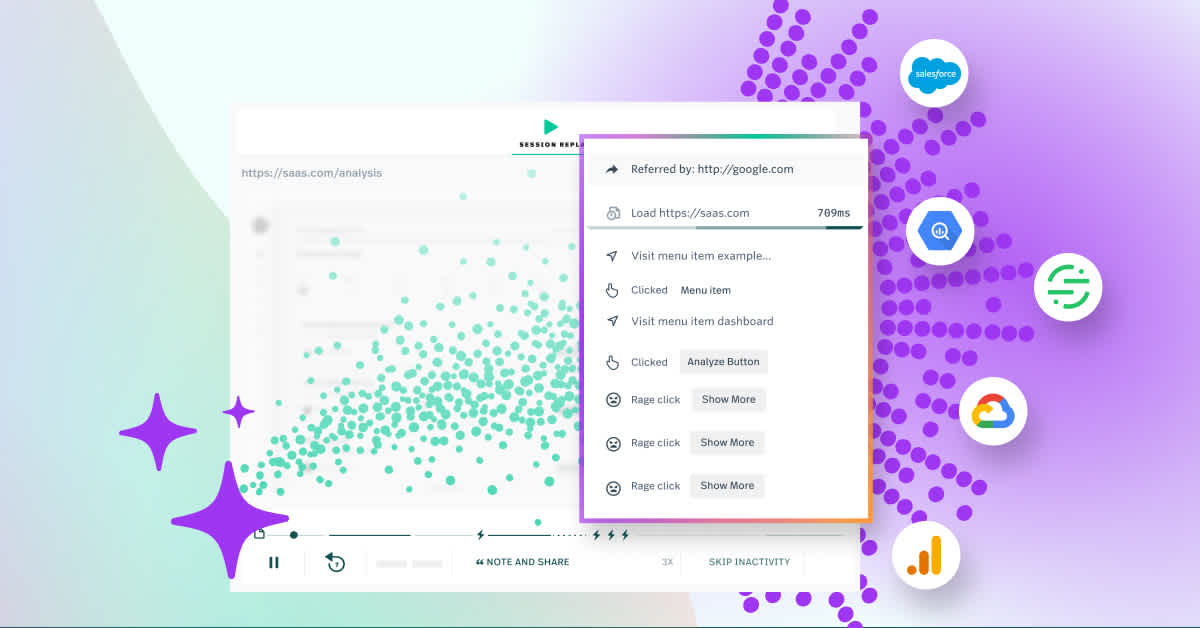Understanding customer behavior is crucial to building loyalty in today’s fast-paced digital world. With customers interacting constantly, “real-time” data sounds like the perfect solution to stay ahead. But what does "real-time" customer behavioral data really mean?
The truth is, there's no one-size-fits-all answer. The ideal timeliness of data depends on what you're trying to achieve. This blog post explores the concept of "just-in-time" customer behavioral data, and how it can empower you to make data-driven decisions and unlock real-time actionable insights.
What is real-time data?
Over my tenure at Fullstory (coming up on seven years, wow), I’ve directly engaged with over 500 customers and prospects, and when formulating the capabilities required of their behavioral data platform, some sense of real-time data is not uncommon.
But upon double-clicking into the requirement, sometimes “real-time” means milliseconds, sometimes minutes, sometimes hours, sometimes days. When it comes to the usefulness of customer behavioral data, truly “real-time" might not always be the most helpful, cost-effective, appropriate, or practical.
In truth, literal "real-time” isn't even possible at all. From the moment a customer takes some action on a site or mobile app, the browser doesn't even respond in genuine real-time. It takes many microseconds for native browser functions to respond to the customer. Therefore, when you define “real-time," you are always working with an abstracted definition, and when an abstraction defines any definition, no definition becomes literal or all-encompassing.
The premise and thesis of this post will suggest an alternative colloquialization. We should use a different term. We should choose a term that is helpful in all contexts, and the helpfulness will be defined by the term’s utility in encouraging deeper discovery into the purpose of the requested data. Instead of using the term "real-time,” which has a literal definition but an abstract meaning, we should use the term "just-in-time,” (JIT) as its literal definition implies the necessity of additional clarity.
JIT data begs the questions:
Just in time for what?
Just in time to be used by whom?
Just in time to enable what specific outcome or capability?
The requirement of JIT digital behavioral data removes the focus on the data itself and places the emphasis squarely where it should be; it focuses the attention on the outcome you were trying to catalyze.
The power of just-in-time data
When we talk about 'real-time' data, it's often associated with lightning-fast millisecond updates that fuel personalization engines. In the context of site performance monitoring, it could also mean achieving to-the-second accuracy in daily reported and aggregated data.
Sure, getting data instantly has its advantages, but crunching and analyzing enormous datasets at those super-high speeds can be costly, impractical, and useless.
Just-in-time data takes a more measured approach, focusing on delivering the right data at the precise moment needed to satisfy a stated and scoped requirement that matters.
Unveiling customer behavior with just-in-time data
Imagine seeing exactly how customers interact with your website or app in granular detail and receiving that information at the very moment a struggling customer is experiencing that digital pain. When do you need that data? Just in time for your support agents to assist them live.
Or, imagine having to-the-second accuracy regarding the performance of your back-end APIs in context with the lag of your site loading spinners or the thrashing of your users’ mouses. The additional behavioral data adds color and context to your server performance data in that scenario. A 10- or 15-minute delay allows additional context about the customer journey to be included in the performance report. In this case, just-in-time data prioritizes context and completeness over timeliness.
Just-in-time customer behavioral data enables practical, measurable, and relevant outcomes for your business. For instance, you can use just-in-time data to see where customers drop off in a checkout funnel and make changes in your next design sprint to improve conversion rates. You can also train a model to identify previously invisible customer segments with specific browsing behaviors and tailor your marketing messages accordingly. Then market to them over the next major retail holiday. By delivering the correct data at the right time, just-in-time data empowers you to act on customer insights and optimize your digital experiences. The data isn’t the focus. Your business’s outcome is the focus.
Equipping yourself for just-in-time user behavior data collection
The key to unlocking the power of just-in-time data lies in scoping your use cases and choosing flexible tools to meet those data needs. You need flexible data collection tools that can adhere to various time requirements at numerous levels of data fidelity and completeness.
Look for tools that can capture customer behavioral data in real time and then deliver that data to your downstream systems at the precise moment and in the correct form required for a given outcome.
For instance, at Fullstory, 100% of customer behavioral data is collected in true “real-time.” Every mouse movement, page load, and network error—click, thrash, change—everything. But capturing it and immediately (real-time) making that available wouldn’t be helpful.
It’s too much data and not in an easily usable form. Some of that data can be used in near-real-time. The recreation of sessions for viewing customer experiences, for example, can be served up and made available for real-time co-browsing in a support experience, but it’s important the interaction analytic event data is processed, cleaned, and structured so it can run on a few minutes delay.
Structure is more important than timeliness when it comes to accurate analytics but timeliness is more important than structure in the context of real time intervention. If you need analytic accuracy in real time, Fullstory enables near real time sequenced streaming webhooks, so if you need some set of data to inform personalization decisions, some set of data can be streamed to satisfy that use case.
Conclusion
The pursuit of a single definition for "real-time" user data can be a misleading chase. The reality is, the ideal data availability depends on your specific use case. By embracing a just-in-time approach, you can ensure you're getting the right data, at the right time, to make data-driven decisions and optimize your customers’ experiences. Just-in-time data accessibility, powered by real-time data capture, is the key to unlocking a new level of customer understanding, personalization and customer delight.





